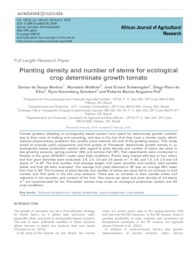Planting density and number of stems for ecological crop determinate growth tomato.
Planting density and number of stems for ecological crop determinate growth tomato.
Autoria: MARTINS, D de S.; WATTHIER, M.; SCHWENGBER, J. E.; SILVA, D. R da; SCHUBERT, R. N.; PEIL, R. M. N.
Resumo: Tomato growers adopting an ecologically based system have opted for determinate growth varieties due to their ease of staking and sprouting, and due to the fact that they have a shorter cycle, which reduces phytosanitary problems that usually occur towards the end of the growing season. This study aimed to evaluate yield components and fruit quality of ‘Floradade’ determinate growth tomato in an ecologically based production system with regard to plant density and number of stems per plant in two growing seasons, spring-summer (SS) and summer-fall (SF). Two experiments were conducted in Pelotas in the years 2010/2011 under open field conditions. Plants were trained with two or four stems and four plant densities were evaluated: 2.0; 2.5; 3.0 and 3.6 plants m-2in SS, and 1.5; 2.0; 2.5 and 3.0 plants m-2 in SF. The fruit number, fruit average weight, fruit yield, ascorbic acid content, total soluble solids and fruit pH were evaluated. The average fruit yield obtained in SF was on average 80% lower than that in SS. The increase of plant density and number of stems per plant led to an increase in fruit number and fruit yield in the two crop seasons. There was an increase in total soluble solids and reduction in the ascorbic acid content of the fruit. Two stemsper plant and plant density of 3.0 plants m-2 are recommended for the ‘Floradade’ tomato crop under an ecological production system and SS crop conditions.
Ano de publicação: 2018
Tipo de publicação: Artigo de periódico
Unidade: Embrapa Clima Temperado
Palavras-chave: Tomate
Observações
1 - Por padrão são exibidas publicações dos últimos 20 anos. Para encontrar publicações mais antigas, configure o filtro ano de publicação, colocando o ano a partir do qual você deseja encontrar publicações. O filtro está na coluna da esquerda na busca acima.
2 - Para ler algumas publicações da Embrapa (apenas as que estão em formato ePub), é necessário ter, no celular ou computador, um desses softwares gratuitos. Sistemas Android: Google Play Livros; IOS: iBooks; Windows e Linux: software Calibre.
Acesse outras publicações
Acesse a Base de Dados da Pesquisa Agropecuária (BDPA) para consultar o acervo completo das bibliotecas da Embrapa.

